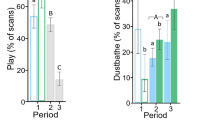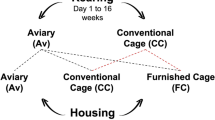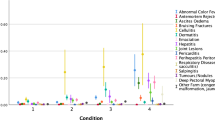Abstract
Hens are raised apart from roosters in modern poultry production, a substantial change from their natural social structure. We compared productivity, injuries, behavior, physiology, microbiome and transcriptome of hens housed with (R+) or without (R−) roosters to quantify the effects of this change in social structure. Hens were raised free-range from 70 to 280 days when 30 birds per treatment were assigned to battery cages until Day 315 (R+C vs. R−C), while 30 birds per treatment remained in free-range pens (R+F vs. R−F). Response to a novel environment and object, behavioral time budgets, cecum microbiome, blood composition and transcriptomic sequencing of thigh muscle and spleen were analyzed. Hens housed without roosters showed better survival, consumed less food, produced more eggs and had better feed conversion. R+F hens clustered around the rooster and were less mobile in the novel environment and object tests. R+F hens displayed the richest microbiome, and the presence of roosters resulted in differentially expressed genes related to muscle development, cellular processes, environmental information processing and immune function. Removing roosters from housed hens intensified desirable characteristics favored by domestication probably operating by deprivation of mating behavior and reduced fear, along with altered microbial and genetic function.
Similar content being viewed by others
References
Agnvall, B., Ali, A., Olby, S., and Jensen, P. (2014). Red Junglefowl (Gallus gallus) selected for low fear of humans are larger, more dominant and produce larger offspring. Animal 8, 1498–1505.
Agnvall, B., Jöngren, M., Strandberg, E., and Jensen, P. (2012). Heritability and genetic correlations of fear-related behaviour in red junglefowlpossible implications for early domestication. PLoS ONE 7, e35162.
Agnvall, B., Katajamaa, R., Altimiras, J., and Jensen, P. (2015). Is domestication driven by reduced fear of humans? Boldness, metabolism and serotonin levels in divergently selected red junglefowl (Gallus gallus). Biol Lett 11, 20150509.
Al-Nasser, A., Al-Khalaifa, H., Al-Saffar, A., Khalil, F., Albahouh, M., Ragheb, G., Al-Haddad, A., and Mashaly, M. (2007). Overview of chicken taxonomy and domestication. World Poultry Sci J 63, 285–300.
Anders, S., and Huber, W. (2010). Differential expression analysis for sequence count data. Genome Biol 11, R106.
Bailey, M.T., Dowd, S.E., Parry, N.M.A., Galley, J.D., Schauer, D.B., and Lyte, M. (2010). Stressor exposure disrupts commensal microbial populations in the intestines and leads to increased colonization by citrobacter rodentium. Infect Immun 78, 1509–1519.
Bélteky, J., Agnvall, B., Johnsson, M., Wright, D., and Jensen, P. (2016). Domestication and tameness: brain gene expression in red junglefowl selected for less fear of humans suggests effects on reproduction and immunology. R Soc Open Sci 3, 160033.
Branciari, R., Mugnai, C., Mammoli, R., Miraglia, D., Ranucci, D., Dal Bosco, A., and Castellini, C. (2009). Effect of genotype and rearing system on chicken behavior and muscle fiber characteristics. J Anim Sci 87, 4109–4117.
Campler, M., Jöngren, M., and Jensen, P. (2009). Fearfulness in red junglefowl and domesticated White Leghorn chickens. Behav Proc 81, 39–43.
Caporaso, J.G., Kuczynski, J., Stombaugh, J., Bittinger, K., Bushman, F.D., Costello, E.K., Fierer, N., Peña, A.G., Goodrich, J.K., Gordon, J.I., et al. (2010). QIIME allows analysis of high-throughput community sequencing data. Nat Methods 7, 335–336.
Chen, S., Xiang, H., Zhang, H., Zhu, X., Wang, D., Wang, J., Yin, T., Liu, L., Kong, M., Li, H., et al. (2019). Rearing system causes changes of behavior, microbiome, and gene expression of chickens. Poultry Sci 98, 3365–3376.
Chen, S., Xiang, H., Zhu, X., Zhang, H., Wang, D., Liu, H., Wang, J., Yin, T., Liu, L., Kong, M., et al. (2018). Free dietary choice and free-range rearing improve the product quality, gait score, and microbial richness of chickens. Animals 8, 84.
Collias, N.E., and Collias, E.C. (1967). A field study of the red jungle fowl in North-Central India. Condor 69, 360–386.
Corr, S.A., Gentle, M.J., McCorquodale, C.C., and Bennett, D. (2003). The effect of morphology on the musculoskeletal system of the modern broiler. Anim Welfare 12, 145–157.
Duggan, B.M., Hocking, P.M., Schwarz, T., and Clements, D.N. (2015). Differences in hindlimb morphology of ducks and chickens: effects of domestication and selection. Genet Sel Evol 47, 88.
Edgar, R.C. (2013). UPARSE: highly accurate OTU sequences from microbial amplicon reads. Nat Methods 10, 996–998.
Edgar, R.C., Haas, B.J., Clemente, J.C., Quince, C., and Knight, R. (2011). UCHIME improves sensitivity and speed of chimera detection. Bioinformatics 27, 2194–2200.
Elfwing, M., Nätt, D., Goerlich-Jansson, V.C., Persson, M., Hjelm, J., and Jensen, P. (2015). Early stress causes sex-specific, life-long changes in behaviour, levels of gonadal hormones, and gene expression in chickens. PLoS ONE 10, e0125808.
Ericsson, M., Fallahsharoudi, A., Bergquist, J., Kushnir, M.M., and Jensen, P. (2014). Domestication effects on behavioural and hormonal responses to acute stress in chickens. Physiol Behav 133, 161–169.
Ericsson, M., and Jensen, P. (2016). Domestication and ontogeny effects on the stress response in young chickens (Gallus gallus). Sci Rep 6, 35818.
Eriksson, J., Larson, G., Gunnarsson, U., Bed’hom, B., Tixier-Boichard, M., Strömstedt, L., Wright, D., Jungerius, A., Vereijken, A., Randi, E., et al. (2008). Identification of the yellow skin gene reveals a hybrid origin of the domestic chicken. PLoS Genet 4, e1000010.
Favati, A., Leimar, O., and Løvlie, H. (2014). Personality predicts social dominance in male domestic fowl. PLoS ONE 9, e103535.
Favati, A., Zidar, J., Thorpe, H., Jensen, P., and Løvlie, H. (2016). The ontogeny of personality traits in the red junglefowl, Gallus gallus. Behav Ecol 27, 484–493.
Forkman, B., Boissy, A., Meunier-Salaün, M.C., Canali, E., and Jones, R.B. (2007). A critical review of fear tests used on cattle, pigs, sheep, poultry and horses. Physiol Behav 92, 340–374.
Hicks, K.M., Onambele-Pearson, G.L., Winwood, K., and Morse, C.I. (2017). Muscle-tendon unit properties during eccentric exercise correlate with the creatine kinase response. Front Physiol 8, 657.
Jackson, S., and Diamond, J. (1996). Metabolic and digestive responses to artificial selection in chickens. Evolution 50, 1638–1650.
Janczak, A.M., and Riber, A.B. (2015). Review of rearing-related factors affecting the welfare of laying hens. Poultry Sci 94, 1454–1469.
Jensen, P. (2014). Behaviour epigenetics—The connection between environment, stress and welfare. Appl Anim Behav Sci 157, 1–7.
Jöngren, M., Westander, J., Nätt, D., and Jensen, P. (2010). Brain gene expression in relation to fearfulness in female red junglefowl (Gallus gallus). Genes Brain Behav 9, 751–758.
Kuhne, F., Sauerbrey, A.F.C., and Adler, S. (2013). The discrimination-learning task determines the kind of frustration-related behaviours in laying hens (Gallus gallus domesticus). Appl Anim Behav Sci 148, 192–200.
Langmead, B., and Salzberg, S.L. (2012). Fast gapped-read alignment with Bowtie 2. Nat Methods 9, 357–359.
Lee, H.J., Jang, M., Kim, H., Kwak, W., Park, W.C., Hwang, J.Y., Lee, C. K., Jang, G.W., Park, M.N., Kim, H.C., et al. (2013). Comparative transcriptome analysis of adipose tissues reveals that ECM-receptor interaction is involved in the depot-specific adipogenesis in cattle. PLoS ONE 8, e66267.
Lehtinen, M.K., Yuan, Z., Boag, P.R., Yang, Y., Villén, J., Becker, E.B.E., DiBacco, S., de la Iglesia, N., Gygi, S., Blackwell, T.K., et al. (2006). A conserved MST-FOXO signaling pathway mediates oxidative-stress responses and extends life span. Cell 125, 987–1001.
Looney, W.J., Narita, M., and Mühlemann, K. (2009). Stenotrophomonas maltophilia: an emerging opportunist human pathogen. Lancet Infect Dis 9, 312–323.
Magoč, T., and Salzberg, S.L. (2011). FLASH: fast length adjustment of short reads to improve genome assemblies. Bioinformatics 27, 2957–2963.
Marchi, D.F., Santilli, J.C., Soares, A.L., Santos, G.R.D., Oba, A., Shimokomaki, M., and Ida, E.I. (2012). Creatine kinase and lactate dehydrogenase activities for stress animal identification and chicken PSE (pale, soft, exudative) meat. Semin Cienc Agrar 33, 3103–3109.
Moreng, R.E., and Avens, J.S. (1985). Poultry science and production (Reston: Reston Publishing Company).
Munukka, E., Rintala, A., Toivonen, R., Nylund, M., Yang, B., Takanen, A., Hänninen, A., Vuopio, J., Huovinen, P., Jalkanen, S., et al. (2017). Faecalibacterium prausnitzii treatment improves hepatic health and reduces adipose tissue inflammation in high-fat fed mice. ISME J 11, 1667–1679.
Okpokho, N.A., and Craig, J.V. (1987). Fear-related behavior of hens in cages: effects of rearing environment, age, and habituation. Poultry Sci 66, 376–377.
Parks, D.H., Tyson, G.W., Hugenholtz, P., and Beiko, R.G. (2014). STAMP: statistical analysis of taxonomic and functional profiles. Bioinformatics 30, 3123–3124.
Pedro, R.E., Candido, N., Guariglia, D.A., Melo, B.P., Bertolini, D.A., Peres, S.B., and Franzói de Moraes, S.M. (2017). Exercise improves cytokine profile in HIV-infected people: A randomized clinical trial. Cytokine 99, 18–23.
Pizzari, T. (2003). Food, vigilance, and sperm: the role of male direct benefits in the evolution of female preference in a polygamous bird. Behav Ecol 14, 593–601.
Price, E.O. (1999). Behavioral development in animals undergoing domestication. Appl Anim Behav Sci 65, 245–271.
Romanov, M.N., and Weigend, S. (2001). Analysis of genetic relationships between various populations of domestic and jungle fowl using microsatellite markers. Poultry Sci 80, 1057–1063.
Roth, L.S.V., and Lind, O. (2013). The impact of domestication on the chicken optical apparatus. PLoS ONE 8, e65509.
Roy, P., and Bandyopadhyay, A. (2014). Spatio-temporally restricted expression of cell adhesion molecules during chicken embryonic development. PLoS ONE 9, e96837.
Sasaguri, K., Yamada, K., Narimatsu, Y., Oonuki, M., Oishi, A., Koda, K., Kubo, K.Y., Yamamoto, T., and Kadoya, T. (2017). Stress-induced galectin-1 influences immune tolerance in the spleen and thymus by modulating CD45 immunoreactive lymphocytes. J Physiol Sci 67, 489–496.
Schütz, K.E., Kerje, S., Jacobsson, L., Forkman, B., Carlborg, Ö., Andersson, L., and Jensen, P. (2004). Major growth QTLs in fowl are related to fearful behavior: possible genetic links between fear responses and production traits in a red junglefowl×white leghorn intercross. Behav Genet 34, 121–130.
Smith, C.L., and Johnson, J. (2012). The chicken challenge - what contemporary studies of fowl mean for science and ethics. Betw Species 15.
Trapnell, C., Pachter, L., and Salzberg, S.L. (2009). TopHat: discovering splice junctions with RNA-Seq. Bioinformatics 25, 1105–1111.
Van Goor, A., Ashwell, C.M., Persia, M.E., Rothschild, M.F., Schmidt, C. J., and Lamont, S.J. (2017). Unique genetic responses revealed in RNA-seq of the spleen of chickens stimulated with lipopolysaccharide and short-term heat. PLoS ONE 12, e0171414.
Weeks, C.A., and Nicol, C.J. (2006). Behavioural needs, priorities and preferences of laying hens. World Poultry Sci J 62, 296–307.
Xiang, H., Chen, S., Zhang, H., Zhu, X., Wang, D., Liu, H., Wang, J., Yin, T., Liu, L., Kong, M., et al. (2018). Transcriptome changes provide genetic insights into the effects of rearing systems on chicken welfare and product quality. J Anim Sci 96, 4552–4561.
Xiang, H., Gao, J., Yu, B., Zhou, H., Cai, D., Zhang, Y., Chen, X., Wang, X., Hofreiter, M., and Zhao, X. (2014). Early Holocene chicken domestication in northern China. Proc Natl Acad Sci USA 111, 17564–17569.
Zhang, P., Yan, T., Wang, X., Kuang, S., Xiao, Y., Lu, W., and Bi, D. (2017). Probiotic mixture ameliorates heat stress of laying hens by enhancing intestinal barrier function and improving gut microbiota. Italian J Anim Sci 16, 292–300.
Zimmerman, P.H., Buijs, S.A.F., Bolhuis, J.E., and Keeling, L.J. (2011). Behaviour of domestic fowl in anticipation of positive and negative stimuli. Anim Behav 81, 569–577.
Acknowledgements
We express sincere thanks to Mr. Fengqi Lu, Mr. Liang Xu, Mr. Weitian Qi, Ms. Mingting Li (Lvdudu Ecological Farm), and Ms. Wan Jia (China Agricultural University) for their great help with the experiment. This work was funded by Guangdong Basic and Applied Basic Research Foundation (2019A1515110453), Foundation for Key Laboratory (2019KSYS011) and Creative Team (2019KCXTD006) in Guangdong Higher Education Institutes, the Guangdong Provincial Key Laboratory of Animal Molecular Design and Precise Breeding (2019B030301010), the Joint Projects of Guizhou Nayong Professor Workstation (201705510410352), and the Scientific Research Start-up Fund for High-level Talents of Foshan University (CGG07154). The funding bodies contributed nothing to the study design, data analyses, data interpretation, or manuscript preparation.
Author information
Authors and Affiliations
Corresponding authors
Additional information
Compliance and ethics
The author(s) declare that they have no conflict of interest.
Supporting Information
Rights and permissions
About this article
Cite this article
Xiang, H., Chen, S., Zhang, H. et al. Removal of roosters alters the domestic phenotype and microbial and genetic profile of hens. Sci. China Life Sci. 64, 1964–1976 (2021). https://doi.org/10.1007/s11427-020-1770-1
Received:
Accepted:
Published:
Issue Date:
DOI: https://doi.org/10.1007/s11427-020-1770-1




